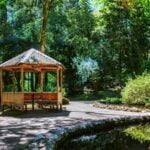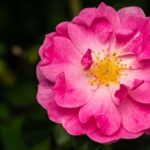With the growing popularity of xeriscaping and water-wise landscaping, desert landscape ideas have become a hot topic for homeowners and landscapers alike. In this article, we will delve into the unique and stunning beauty of desert landscapes, providing inspiration and tips for creating your own arid oasis. From choosing the right plants to incorporating hardscaping features, we will explore the various elements that make desert landscaping both practical and visually appealing.
When it comes to designing a desert landscape, one must carefully consider the types of plants that can thrive in such harsh conditions. We will discuss how to select the right succulents, cacti, and other drought-tolerant plants that can not only survive but also thrive in a desert environment. Additionally, we will touch on utilizing natural elements such as rocks, sand, and gravel to enhance the authenticity of a desert-inspired garden.
In addition to plant selection and natural elements, hardscaping features play a crucial role in creating a visually striking desert landscape. We will explore different ways to incorporate elements like pathways, rock gardens, and decorative boulders into your design. Ultimately, our goal is to provide you with a comprehensive understanding of how to embrace and showcase the distinctive beauty of desert landscapes in your own outdoor space.
Choosing the Right Plants for a Desert Landscape
When it comes to creating a stunning desert landscape, choosing the right plants is crucial. The key to a successful desert garden lies in selecting plants that are able to thrive in arid conditions and require minimal water.
Some popular options for desert landscaping include succulents such as agave, yucca, and aloe vera, as well as cacti like prickly pear and barrel cactus. These plants not only add visual interest to the landscape but also require little maintenance, making them ideal choices for those looking to create a sustainable and low-maintenance garden.
In addition to succulents and cacti, there are also other types of plants that can thrive in a desert landscape. Drought-tolerant trees such as Palo Verde and Mesquite are great options for adding height and shade to the garden while requiring minimal watering.
When it comes to ground cover, consider using gravel or mulch in place of traditional grass, as these materials help conserve water and create beautiful textures within the landscape. By carefully selecting the right combination of plants, it is possible to create a diverse and visually appealing desert garden that requires little water and maintenance.
For those looking to add some color to their desert landscape, there are also flowering plant options that can thrive in arid environments. Flowers such as Desert Marigold, Mexican Evening Primrose, and Penstemon are just a few examples of colorful plants that can bring vibrancy to a desert garden without requiring excessive watering or maintenance.
| Desert Plants | Watering Needs |
|---|---|
| Agave | Low |
| Yucca | Low |
| Aloe Vera | Low |
Utilizing Natural Elements in Desert Landscaping
Desert landscapes are known for their unique and stark beauty, with their vast stretches of sand, rocky formations, and sparse vegetation. When it comes to designing a desert landscape, utilizing natural elements is key to capturing the essence of these environments. Here are some ideas for incorporating natural elements into your desert landscaping:
- Rocks and boulders: Rocks and boulders are essential features in a desert landscape. They can be used to create focal points, define borders, or even mimic the natural rock formations found in the desert. Choose a variety of sizes and shapes to add visual interest to your design.
- Native plants: When selecting plants for your desert landscape, it’s important to choose species that are well-adapted to the arid conditions. Look for native succulents, cacti, and drought-tolerant shrubs and grasses that thrive in desert environments. Not only will they require less water, but they will also enhance the authenticity of your desert garden.
- Sand and gravel: Embrace the natural texture of the desert by incorporating sand or gravel into your landscaping design. Use these materials as pathways, ground cover, or as a base for potted plants. They not only add an earthy element to your garden but also help with water retention and drainage.
When designing a desert landscape, it’s essential to work with the natural elements of the environment rather than against them. By incorporating rocks, native plants, and sandy textures into your design, you can create a stunning and sustainable desert garden that celebrates the beauty of arid landscapes.
Incorporating Hardscaping Features in a Desert Landscape
Choosing the Right Materials
When selecting materials for hardscaping in a desert landscape, it’s essential to consider factors such as durability, heat resistance, and ability to complement the natural environment. Opt for materials like natural stone, gravel, and concrete pavers that can withstand extreme temperatures and require minimal upkeep. These materials also blend seamlessly with the surrounding desert scenery.
Creating Functional Spaces
Incorporating hardscaping features allows you to create functional outdoor spaces within your desert landscape. Consider adding a patio or seating area made from heat-resistant materials where you can relax and enjoy the beauty of your garden. Additionally, pathways made from gravel or stepping stones can guide visitors through the landscape while reducing foot traffic on delicate desert plants.
Conserving Water Through Design
Hardscaping plays a crucial role in water conservation within a desert landscape. By minimizing the amount of irrigated turf or garden beds, hardscaped areas help reduce overall water consumption while still providing visual interest and functionality. Incorporating permeable paving materials also allows rainwater to penetrate the soil and replenish groundwater reserves, supporting the sustainability of your desert garden.
By integrating carefully selected hardscaping features into your desert landscape design, you can create an inviting and low-maintenance outdoor space that complements the unique beauty of arid environments. From choosing heat-resistant materials to creating functional spaces for relaxation and entertainment, thoughtful hardscaping enhances both the aesthetic appeal and practicality of a desert garden.
Creating a Focal Point in a Desert Landscape
When creating a desert landscape, it’s important to consider how to create a focal point that will draw the eye and add visual interest to the space. Here are some ideas for creating a stunning focal point in your desert landscape:
1. Unique rock formations: Incorporating unique and interesting rock formations can add an intriguing focal point to your desert landscape. Consider using large, dramatic boulders or sculptural rock formations that will stand out against the desert backdrop.
2. Water features: While it may seem counterintuitive in a desert landscape, incorporating a water feature can create a striking focal point. A small pond, waterfall, or even a simple fountain can add an element of tranquility and provide contrast to the arid surroundings.
3. Artistic sculptures: Adding artistic sculptures or metal artwork can create a visually captivating focal point in your desert landscape. Look for pieces that complement the natural beauty of the desert and add a touch of creativity to the space.
In addition to these ideas, don’t be afraid to get creative with other unique elements such as colorful ceramic pots, ornamental grasses, or even a striking agave plant as part of your focal point design. Embracing the stark beauty of the desert landscape while adding visually compelling elements will result in an unforgettable outdoor space.
Remember that no matter which idea you choose, it’s essential to consider how your chosen focal point will harmonize with the overall design and aesthetic of your desert landscape. And most importantly – have fun with it. Creating a focal point is about expressing your personal style and enhancing the natural beauty of the desert landscape.
How to Maintain a Thriving Desert Garden
Maintaining a thriving desert garden requires careful planning and regular maintenance to ensure the longevity and health of the landscape. One essential factor to consider is irrigation. With minimal rainfall in desert regions, it’s crucial to establish a proper watering schedule for plants in a desert landscape. Drip irrigation systems are an efficient way to provide water directly to the roots of plants, reducing water waste and promoting growth.
In addition to watering, proper soil preparation is vital for a thriving desert garden. Desert soil is often nutrient-poor and may lack organic matter, so adding compost or other soil amendments can improve the overall health of the soil and support plant growth. It’s also important to use mulch in a desert garden to help retain moisture in the soil, reduce erosion, and suppress weed growth.
Another key aspect of maintaining a thriving desert garden is regular pruning and maintenance of plants. Trimming back dead or overgrown foliage not only improves the appearance of the landscape but also promotes healthy new growth. Additionally, staying vigilant against pests and diseases is crucial in preserving the vitality of a desert garden.
| Aspect | Maintenance Tips |
|---|---|
| Irrigation | Establish a proper watering schedule; Consider drip irrigation systems |
| Soil Preparation | Add compost or soil amendments; Use mulch for moisture retention |
| Pruning and Maintenance | Regularly trim back dead or overgrown foliage; Stay vigilant against pests and diseases |
Desert Landscape Design Tips for Small Spaces
When it comes to desert landscape ideas for small spaces, there are plenty of creative ways to make the most out of limited area. One of the key considerations when designing a desert landscape in a small space is choosing the right plants that will thrive in a confined area.
Opt for low-maintenance succulents and cacti that can add visual interest without taking up too much space. Consider incorporating native desert plants that are well-suited to the climate and will require minimal water and maintenance.
In addition to selecting the right plants, utilizing natural elements can also help maximize a small desert landscape. Incorporating rocks, gravel, and sand can create a visually appealing and low-maintenance environment. These natural elements not only add texture and dimension but also contribute to the overall arid aesthetic of a desert landscape design.
When working with limited space in desert landscaping, it’s important to carefully plan the hardscaping features. Consider including pathways or stepping stones made from natural materials like flagstone or gravel to create visual interest while also serving a practical purpose.
Additionally, incorporating small-scale hardscaping elements such as decorative pots or sculptures can add personality to the space without overwhelming it. By carefully considering plant selection, natural elements, and hardscaping features, it is possible to create a stunning desert landscape design even in a small outdoor area.
Case Studies of Stunning Desert Landscape Projects
There are countless ways to create stunning desert landscapes, and looking at a few case studies can provide inspiration for your own project. One example of a breathtaking desert landscape is the Desert Botanical Garden in Phoenix, Arizona.
This garden showcases the incredible diversity of desert plants, from towering saguaros to delicate wildflowers, all artfully arranged to highlight their natural beauty. By selecting plants that thrive in the arid climate and arranging them in thoughtful combinations, this landscape demonstrates how to create a visually striking and sustainable desert garden.
Another impressive desert landscape project is the Wave Garden in Palm Springs, California. This modern desert oasis features a combination of native plants, sleek hardscaping, and carefully positioned focal points that create an inviting and peaceful outdoor space.
The use of natural elements such as boulders and pebbles adds texture and interest to the design, while also enhancing the overall sense of harmony with the surrounding environment. Additionally, incorporating hardscaping features like pathways and seating areas allows visitors to enjoy the beauty of the desert landscape while also providing functional spaces for relaxation and contemplation.
The Red Rock Canyon Conservation Area in Nevada offers yet another inspiring example of a stunning desert landscape. Through careful conservation efforts, this area has preserved its natural beauty while also allowing visitors to experience the awe-inspiring scenery through designated trails and viewpoints.
The strategic use of focal points such as unique rock formations and picturesque overlooks highlights the dramatic geological features of the desert landscape. By maintaining a thriving ecosystem that is both visually captivating and ecologically sustainable, this case study demonstrates how thoughtful design choices can enhance the inherent beauty of a desert environment.
Conclusion
In conclusion, embracing the unique beauty of desert landscapes can result in stunning and sustainable outdoor spaces that are both visually appealing and environmentally friendly. When it comes to desert landscape ideas, the possibilities are endless. By choosing the right plants, utilizing natural elements, incorporating hardscaping features, creating focal points, and following proper maintenance techniques, anyone can create a thriving desert garden.
One of the most important aspects of desert landscaping is to carefully select plants that are well-suited for the harsh climate and minimal rainfall. Utilizing natural elements such as rocks, gravel, and sand can further enhance the aesthetic appeal of a desert landscape while also reflecting the natural environment. Hardscaping features such as pathways, retaining walls, and architectural structures also play a crucial role in defining the layout and character of a desert garden.
For those with limited outdoor space, desert landscape design tips for small spaces can provide valuable insights on how to maximize the potential of a compact area. Additionally, studying case studies of stunning desert landscape projects can offer inspiration and practical ideas for creating one’s own unique outdoor oasis. Ultimately, embracing the beauty of desert landscapes involves understanding their distinct characteristics and working with them to achieve an aesthetically pleasing and sustainable garden that thrives in its environment.
Frequently Asked Questions
How Do You Plan a Desert Landscape?
Planning a desert landscape involves considering the unique climate and soil conditions of the area. It’s important to choose plants that are well-adapted to drought and high temperatures, such as succulents and cacti.
Incorporating hardy, native plants can help conserve water and create a more sustainable landscape. Additionally, using decorative rocks and gravel can add texture and visual interest to the design while also reducing the need for irrigation.
What Does a Desert Landscape Look Like?
A desert landscape is characterized by its dry, arid environment with sparse vegetation and expansive landscapes. The terrain often features rocky or sandy soil, low-growing shrubs, and cacti adapted to conserve water in harsh conditions.
The color palette tends to be earthy with hues of brown, red, and green, reflecting the natural tones of the desert environment. The overall appearance is minimalist yet striking in its simplicity.
How to Decorate a Desert Garden?
Decorating a desert garden involves incorporating elements that complement the natural surroundings while adding visual appeal. This may include using decorative rocks and stones to create pathways or focal points within the garden.
Planting groupings of native succulents and cacti in different shapes and sizes can also add texture and variety to the space. Additionally, incorporating outdoor art or sculptures that resonate with the desert theme can enhance the overall aesthetic of the garden.

Welcome to my gardening blog! I am passionate about plants and enjoy sharing my knowledge and experiences with others. In this blog, I will write about everything related to gardening, from tips on how to get started to updates on my own garden projects.





